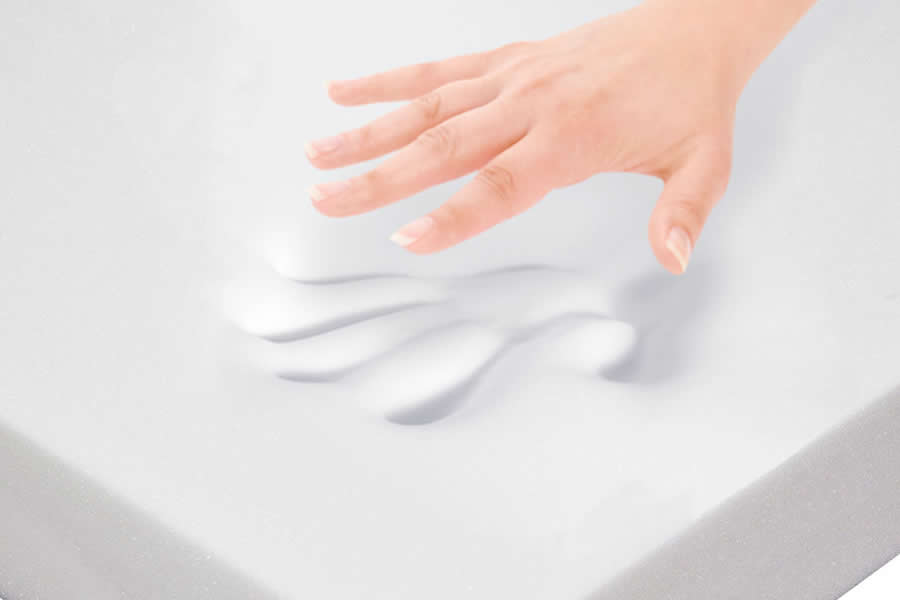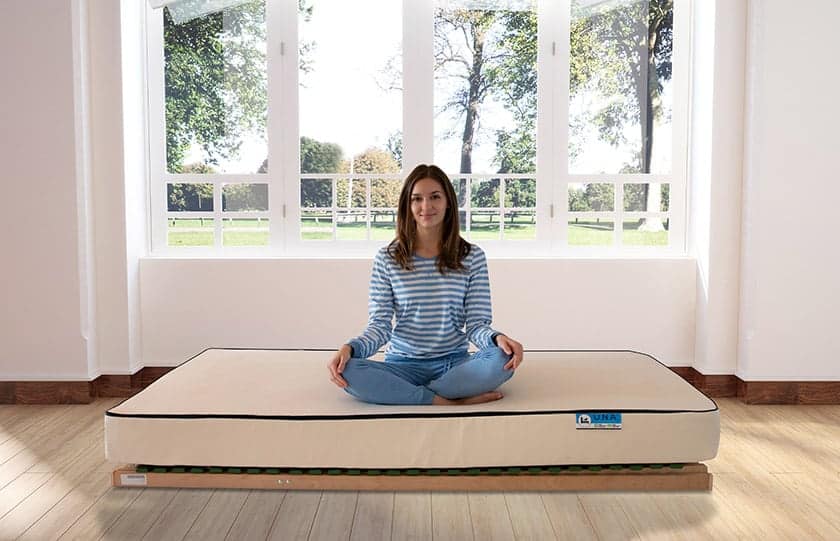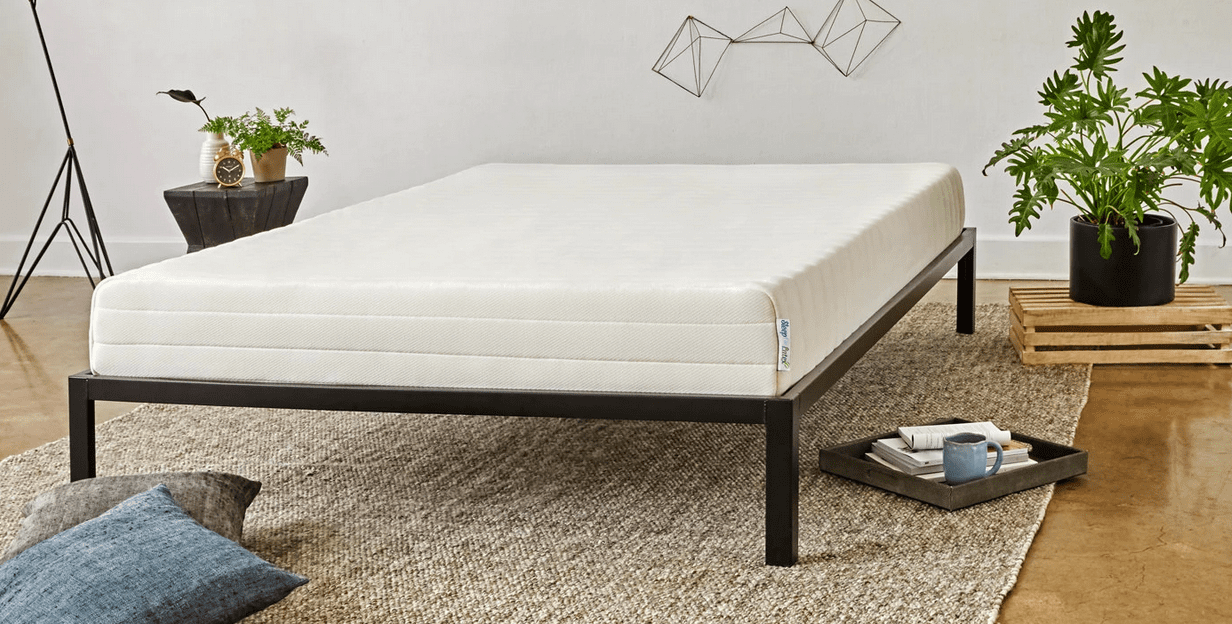So you’re in the market for a mattress upgrade, or perhaps your old foam mattress has started to develop lumps and sags in the middle.
There are a myriad of choices out there with different materials, firmness, and sizes. A mattress is so personal that each person’s perfection can be someone else’s aches and pains.
The first thing to consider would be the filling of the mattress. Memory foam and latex mattresses are often compared with each other, both layered with foam beds that adjust to your body. Let’s compare the two and see why an organic latex mattress might be the best choice for you!
What Is Memory Foam?

Memory foam was first designed for airplane seats in the 1960s. It is made with polyurethane foam and other chemicals to make it more responsive.
The resulting viscoelastic foam conforms to pressure or body heat but bounces back to its original shape when pressure is removed. The heat from your body softens it at appropriate points when you sleep and conforms to the curves and lines of your body. It would suit those that prefer a softer sleeping surface.
Foam is not a natural material and cannot be manufactured without the use of chemicals. While they are not 100% natural, many mattresses are eco friendly and free of harmful chemicals, VOCs or flame retardants.
What Is A Latex Mattress?

There are 3 types of latex mattresses: natural, synthetic and blended.
Natural latex is produced and harvested from the sap of the rubber tree, or “hevea brasiliensis”. From there, the sap goes through the Dunlop or Talalay process to create latex foam. A high quality organic latex mattress that has reputable certification will be more than 95% organic.
Synthetic latex is made from petrochemicals to mimic the feel of natural latex. Manufacturers have been using synthetic latex in mattresses because of the lower production and manufacturing cost. Synthetic latex can have high levels of toxic chemicals that can cause health problems.
Blended latex is a hybrid of the two.
So Why A Latex Mattress?

1. Eco-Friendly
These eco-friendly mattresses are not only good for the environment, but are made to meet the highest GOLS (Global Organic Latex Standards) certification standards. GOLS only ever certifies latex that comes from sustainable and eco-friendly growth practices, and a GOLS certification will ensure that the farming and manufacturing process was evaluated at every stage of production and the raw materials are certified organic.
Natural latex as mentioned above, is produced from the sap of the rubber tree. Each tree can produce sap for up to 30 years. The production of latex not only encourages sustainable and environmentally-friendly tree growth, it is also biodegradable and will stay out of landfills.
For more Eco-friendly products to compliment your next eco-friendly mattress, check out our friend at Ethical Bedding.
2. Hypoallergenic and Antimicrobial
Can you imagine being allergic to your own home? According to a study by AllergyUK, 3 out of 4 people who suffer from allergies have symptoms in their own bedrooms.
Mold, mildew, dust mites and other nasties love mattresses and bedding. Dust mites, one of the leading causes of bedroom allergies, are microscopic bugs that live in our bedding, mattresses, pillows and carpets. One study of several foam mattresses found that any used mattress can have up to 10 million dust mites in it!
Latex is naturally antimicrobial, repelling harmful organisms and making it an excellent choice for people with sensitive skin and allergies.
3. Naturally Flame Retardant
All UK mattresses must meet the fire safety standards and must be fire resistant to a cigarette or smoulder test.
Organic materials such as cotton and wool can be used as natural flame retardants, but because they are more expensive to manufacture and produce, Antimony, Boric Acid and Halogenated Flame Retardants (HFRs) are more commonly used. Prolonged exposure to these chemicals have been linked to serious health complications such as damaging the central nervous system, cancer, reproduction problems and cancer.
The US and some countries in Europe have already banned the use of some of these flame retardants but in the UK, these chemicals are still in use.
Natural latex is fire resistant, while cotton and wool can also be used as natural flame retardants.
4. Breathable
The core of a latex mattress has tiny holes or perforations that are added in the manufacturing process. This is to keep the heat flow through the latex consistent when baking.
Latex also has an open-cell structure that permits constant airflow, especially if other breathable materials like wool and cotton are used for covers. Great for those that like to sleep cooler!
5. Durable
Natural latex mattresses have an average lifespan of 12-20 years, while foam mattresses last about 5-7 years. Rubber is a strong, resilient material that naturally rebounds once pressure is removed and can retain its original shape over many years of use.
6. Joint Support
Latex mattresses tend to be firmer than foam mattresses, cradling heavy body parts such as hips and shoulders, and supporting the lighter areas like neck and back.
The support of latex will be beneficial for those with back and joint pain, providing pressure relief and maintaining alignment of the spine. Many medical professionals such as osteopaths, physical therapists and chiropractors recommend latex mattresses to help with pain relief.
7. Perimeter Support
The edges of most mattresses will give way to your weight when you sit. Some will have firmer sides as “perimeter support”.
That means that another type of material, usually a dense, cheap foam, is used around the edge to firm up the edges. With a high quality natural latex mattress, you shouldn’t need perimeter support.
8. Feel and Comfort
This comes down to personal preference.
Those who prefer latex are usually looking for a mattress with more bounce, a faster response time and a more generalized compression. Foam contours to your body, molding it to your shape and giving the feeling of “sinking” into bed.
Latex allows sinkage and general compression, preventing the “stuck” or overly-enveloped feel that can sometimes accompany memory foam.
